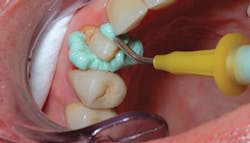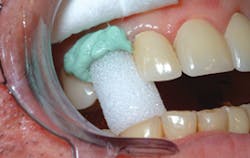Cordless done right with GingiTrac
by Michael DiTolla, DDS, FAGD
When I saw Centrix had developed GingiTrac, a gingival retraction product that is a vinyl polysiloxane (VPS) material, I knew the company must have been in the field talking to dentists, since dentists have observed how VPS materials stop bleeding.
Centrix also added an aluminum sulfate astringent to help ensure that any gingival tissue inadvertently damaged during tooth preparation will coagulate prior to the impression. Unlike with retraction cord, the coagulum will not stick to the silicone GingiTrac, so there is no bleeding when it is removed.
The first observation you will make when you try GingiTrac is the simplicity of placement. Dentists are familiar with the handling characteristics of VPS – most other noncord retraction materials make you fight to get them in the sulcus with no guarantee of success.
Since the viscosity of VPS materials is optimized for placement in the sulcus, it helps ensure you will get GingiTrac into the sulcus without frustration or waste (Figure 1). As I syringe GingiTrac into the sulcus around the prepared tooth, my assistant has syringed GingiTrac into the GingiCap that I place on the prepped tooth and have the patient bite on with medium force (Figure 2).
I use GingiTrac in conjunction with GingiCap because I am a huge fan of gingival compression. When the patient bites on the GingiCap, I routinely see the gingiva blanch all the way to the vestibule. The combination of the VPS, the aluminum sulfate, and the compression from the cap is more than enough to routinely give me a blood-free, retracted impression on the first try.
The GingiTrac is fully set and ready for removal after two minutes. There are no difficult pastes or gels to rinse out of the sulcus when you are ready to impress. Simply grab the GingiCap with cotton pliers and the GingiTrac comes out. It leaves no residue, just a dry sulcus.
Another great use for GingiTrac is when I am seating a crown and the interproximal tissue is bleeding from irritation or temporary cement removal. My assistant places GingiTrac and has the patient bite on a GingiCap. In two minutes, I can cement the crown in a blood-free environment without fear of contamination.
Since 77% of the cases we receive at the lab are for single-unit crowns, I applaud Centrix for making GingiTrac available in the Mini-Mix size to help minimize waste (Figure 3). These convenient single-dose tips are much easier to handle than a bulky automix gun, and I think they are the most cost-effective way to go cordless.
If you have struggled with other noncord retraction materials in the past, I encourage you to try GingiTrac and GingiCap. In terms of placement, effectiveness, and versatility, they are in a special class.
Michael DiTolla, DDS, FAGD, is the director of clinical research and education at Glidewell Laboratories in Newport Beach, Calif. He lectures nationwide on both restorative and cosmetic dentistry. Dr. DiTolla has several free clinical programs available on DVD through Glidewell Laboratories or online at www.glidewelldental.com.
Past DE Issues



